
Best Hospital Bed for Stroke Patients at Home (Buyer's Guide)
📋 KEY TAKEAWAYS
| Feature | Importance for Stroke Patients |
|---|---|
| Height Adjustment | Critical for safe transfers with hemiparesis |
| Side Rails | Essential for support during repositioning and fall prevention |
| Positioning Options | Vital for neurological recovery and preventing complications |
| Pressure Relief | Prevents pressure ulcers during extended recovery periods |
| Caregiver Access | Reduces strain for helpers during rehabilitation |
Best Overall: Icare Adjustable Electric Home Hospital Bed IC333 – Combines therapeutic positioning with home-friendly design
Best for Hemiplegia: Medacure Ultra Low Hospital Bed ULB7/30-CLS – Optimal height adjustment for affected-side transfers
Best for Pressure Relief: Prius Lateral Alternating Pressure Mattress – Prevents complications during extended recovery
Stroke recovery at home requires specialized support to address the unique mobility challenges, positioning needs, and therapy requirements of patients. A properly equipped hospital bed can significantly improve recovery outcomes, prevent complications, and reduce caregiver strain during this critical rehabilitation period.
After extensive research and consultation with stroke rehabilitation specialists, the Icare Adjustable Electric Home Hospital Bed - IC333 emerges as the best overall option for stroke patients recovering at home. This premium hospital bed combines essential therapeutic positioning capabilities with residential aesthetics and exceptional ease of use for patients with neurological deficits.
In this comprehensive guide, we'll analyze the specific requirements for hospital beds designed for stroke recovery and recommend specialized options to address various post-stroke complications, including hemiparesis, spasticity, and sensory deficits.
Critical Hospital Bed Features for Stroke Recovery
Stroke patients face unique challenges that directly impact bed selection, including one-sided weakness (hemiparesis), spasticity, balance deficits, and increased risk of pressure injuries.
| Feature | Standard Hospital Bed | Stroke-Optimized Hospital Bed |
|---|---|---|
| Height Range | 13"-26" typical | 7"-30" extended range |
| Side Rail Design | Basic prevention | Therapy-supporting with grip points |
| Positioning | Basic head/foot elevation | Advanced neurological positioning |
| Control Access | Standard remote | Multiple access points for hemiparesis |
| Pressure Management | Basic foam mattress | Advanced alternating pressure systems |
| Mobility Support | Limited assistance features | Comprehensive transfer and mobility aids |
Critical Height Adjustment for Hemiparesis
Stroke patients typically experience weakness or paralysis on one side of the body (hemiparesis), making bed transfers particularly challenging and dangerous.
Key height adjustment requirements for stroke patients:
- Extended low position: Beds that lower to 7"-12" from the floor facilitate safer transfers for patients with limited standing stability
- Appropriate transfer height: Precise height adjustment to match wheelchair level for seated transfers
- Weight-bearing practice: Incremental height settings to gradually increase weight-bearing during therapy
- Fall prevention: Ultra-low positions minimize injury risk when patients attempt independent transfers
- Floor lock stability: Secure positioning during transfers when balance is compromised
The Medacure Ultra Low Hospital Bed ULB7/30-CLS excels for stroke patients with its 7"-30" height range and robust locking system for $1,741, providing optimal safety during the challenging transfer process.
Therapeutic Side Rails for Neurological Recovery
Properly designed side rails serve multiple critical functions in stroke recovery beyond basic fall prevention.
Therapeutic rail functions for stroke rehabilitation:
- Mobility support: Provides leverage points for patients to practice self-positioning with their unaffected side
- Balance assistance: Offers stability during seated edge-of-bed exercises
- Transfer support: Serves as a grab point during stand-pivot transfers
- Exercise integration: Enables in-bed strengthening exercises during early recovery
- Caregiver leverage: Provides assistance points for helpers during repositioning
Quality options like the Icare Occupation Therapist U-Assist Side Rail are specifically designed to support the rehabilitation process with ergonomic grip points and stable support surfaces.
Neurological Positioning Capabilities
Precise positioning is essential for stroke recovery to prevent complications and support neurological rehabilitation.
Essential positioning capabilities for stroke patients:
- Reverse Trendelenburg: Helps manage increased intracranial pressure in early recovery
- Progressive head elevation: Supports gradual transition from supine to seated positions
- Anti-spasticity positioning: Specific angles to reduce abnormal muscle tone
- Swallowing safety: Precise head elevation to reduce aspiration risk during feeding
- Hemiplegic positioning: Supports proper alignment of affected limbs to prevent contractures
The Trendelenburg Costcare Adjustable Medical Bed B337 offers the advanced positioning capabilities necessary for these neurological applications at $1,675.
Pressure Management for Extended Recovery
Stroke patients face heightened pressure injury risk due to sensory deficits, reduced mobility, and extended bed time during recovery.
Critical pressure management features for stroke recovery:
- Alternating pressure surfaces: Active pressure redistribution for immobile patients
- Zoned support: Extra protection in high-risk areas affected by hemiparesis
- Lateral rotation: Assisted turning to compensate for one-sided weakness
- Microclimate management: Controls moisture and temperature to protect compromised skin
- Positioning support: Maintains therapeutic alignment of affected limbs
The Prius Lateral Alternating Pressure Mattress provides exceptional pressure management with lateral rotation specifically beneficial for hemiplegic patients.
Accessibility Features for Neurological Deficits
Stroke often impacts cognitive processing, visual perception, and fine motor control, necessitating specialized accessibility features.
Accessibility considerations for stroke patients:
- Multiple control locations: Allows access from either side, accommodating hemiparesis
- Simple, high-contrast controls: Supports patients with visual or cognitive deficits
- One-touch positioning: Reduces the need for fine motor coordination
- Memory settings: Maintains consistent therapeutic positions without complex adjustment
- Caregiver controls: Allows assistance when patient operation is challenging
The top-recommended Icare Adjustable Electric Home Hospital Bed - IC333 includes these accessibility features with intuitive controls designed for users with neurological limitations.
Best Hospital Beds for Specific Post-Stroke Conditions
Different stroke effects require specialized bed features to maximize recovery and comfort.
Best for Hemiplegia/Hemiparesis (One-Sided Weakness)
| Feature Needed | Why It's Critical |
|---|---|
| Extended Height Range | Allows precise matching to affected-side transfer capabilities |
| Asymmetrical Rails | Can be configured differently on affected vs. unaffected sides |
| Stable Transfer Surface | Compensates for one-sided balance deficits |
| Control Placement | Accessible from unaffected side |
For patients with significant hemiplegia or hemiparesis, we recommend the Medacure Ultra Low Hospital Bed ULB7/30-CLS ($1,741) which features:
- 7"-30" height range for optimal transfer safety
- Floor lock system providing exceptional stability during affected-side transfers
- Compatibility with asymmetrical side rail configurations
- Multiple control access points accommodating unaffected-side operation
- Robust frame supporting rehabilitation exercises
This bed's extreme low position is particularly valuable for patients relearning transfers with hemiparesis, as it significantly reduces fall injury risk during this challenging rehabilitation phase.
Best for Stroke-Related Spasticity and Tone Management
Abnormal muscle tone following stroke requires specialized positioning capabilities to manage spasticity and prevent contractures.
For these challenging cases, the Costcare Trendelenburg Adjustable Hospital Bed B730 ($4,300) offers:
- Precise therapeutic positioning for spasticity reduction
- Multi-segment articulation supporting proper limb alignment
- Memory position settings for consistent tone management
- Trendelenburg capabilities for advanced positioning protocols
- Robust construction handling spastic movements safely
This advanced bed provides the positioning precision required by physical and occupational therapists implementing home spasticity management programs.
Pair with the Prius Lateral Alternating Pressure Mattress for added spasticity management through controlled sensory input.
Best for Dysphagia and Aspiration Risk
Many stroke patients experience swallowing difficulties (dysphagia) with associated aspiration risk, requiring specific bed capabilities.
For dysphagia management, the Trendelenburg Costcare Adjustable Medical Bed B337 ($1,675) provides:
- Precise upright positioning for safer swallowing
- Controlled recline angles following feeding
- Stable positioning during swallowing therapy exercises
- Quick adjustment capability for aspiration response
- Memory settings for consistent therapeutic angles
This bed's precise positioning capabilities support the dysphagia management protocols recommended by speech-language pathologists during home recovery.
Best for Long-Term Recovery and Pressure Management
Stroke recovery often extends over months, requiring beds that balance therapy needs with long-term comfort and pressure management.
Our top overall recommendation, the Icare Adjustable Electric Home Hospital Bed - IC333 ($3,200), excels for extended recovery with:
- Residential appearance reducing institutional feel during long recovery
- Premium comfort features for extended bed time
- Complete electric operation accessible to patients with limited strength
- Compatible with advanced pressure management mattresses
- Robust construction maintaining performance over extended use
Combined with the ICare IC30 ActiveX Gel-Infused Hospital Bed Mattress, this system provides optimal long-term recovery support with superior pressure protection.
Essential Hospital Bed Accessories for Stroke Rehabilitation
Effective stroke recovery requires specialized accessories that support the rehabilitation process.
Mobility Support Accessories
Essential mobility aids for stroke patients:
- Trapeze bars/overhead poles: The Icare Homecare Over Bed Pole provides upper body leverage for repositioning
- Bed rails with multiple grip points: Support for various transfer techniques
- Transfer boards: Facilitate sliding transfers for those with limited standing ability
- Edge cushions: Create stable sitting surfaces for edge-of-bed exercises
- Bed handles: Provide secure grip points during position changes
These accessories significantly enhance the rehabilitation value of hospital beds by supporting therapy exercises and gradual independence development.
Positioning Accessories for Neurological Recovery
Specialized positioning supports:
- Adjustable overbed tables: The Icare Over Bed Table with C-shape Base supports upper extremity therapy
- Wedge cushions: Maintain proper affected-side alignment
- Limb positioners: Prevent contractures in affected extremities
- Multi-angle backrests: Support varied therapeutic positions
- Foot positioning boards: Prevent foot drop complications
Proper positioning is crucial for neurological recovery, making these accessories essential components of the stroke rehabilitation environment.
Communication and Control Adaptations
Stroke often impacts communication and control abilities, requiring specialized access solutions.
Accessibility enhancements:
- Extended remote controls: Easier to reach from various positions
- Large-button interfaces: Support for those with fine motor challenges
- Voice-activated controls: Options for severely impaired patients
- Mounting brackets: Position controls within reach of unaffected side
- Call systems: Ensure help access when needed
These adaptations are particularly important for patients with aphasia, apraxia, or significant hemiplegia affecting their ability to operate standard controls.
Choosing the Optimal Hospital Bed for Stroke Recovery Phases
Stroke recovery progresses through distinct phases, each with unique bed requirements.
| Recovery Phase | Primary Bed Needs | Recommended Bed |
|---|---|---|
| Acute Recovery (0-3 months) |
Maximum positioning control Highest safety features Pressure management |
Costcare Trendelenburg B730 |
| Sub-Acute Recovery (3-6 months) |
Transfer safety Rehabilitation support Positioning flexibility |
Medacure Ultra Low ULB7/30 |
| Long-Term Recovery (6+ months) |
Comfort emphasis Independence support Home integration |
Icare Adjustable IC333 |
Acute Recovery Phase (First 3 Months)
In the initial recovery period, medical management and complication prevention are primary concerns.
The Costcare Trendelenburg Adjustable Hospital Bed B730 ($4,300) is ideal for this phase with:
- Advanced clinical positioning for neurological recovery
- Maximum safety features when deficits are most severe
- Superior caregiver access during high-dependency period
- Precise positioning for complication prevention
- Compatibility with medical monitoring equipment
This period requires the highest level of medical functionality as the foundation for successful rehabilitation.
Sub-Acute Recovery Phase (3-6 Months)
As rehabilitation intensifies, transfer safety and therapeutic support become paramount.
The Medacure Ultra Low Hospital Bed ULB7/30-CLS ($1,741) supports this phase through:
-
Floor lock system providing stability during therapy exercises
- Height range supporting progressive transfer training
- Supportive features for home therapy protocols
- Balance of clinical function and home integration
This bed's focus on transfer safety aligns perfectly with this critical rehabilitation phase when patients are relearning basic mobility skills.
Long-Term Recovery Phase (6+ Months and Beyond)
For extended recovery periods, balance between therapeutic function and home integration becomes crucial.
Our top overall recommendation, the Icare Adjustable Electric Home Hospital Bed - IC333 ($3,200), is ideal for long-term recovery with:
- Home-friendly appearance reducing institutional feel
- Full electric functionality supporting independence
- Premium comfort for extended use
- Durable construction for years of reliable service
- Compatibility with progressive independence accessories
This bed supports the transition from intensive rehabilitation to long-term adaptation, maintaining necessary medical functionality while enhancing quality of life through residential aesthetics.
Mattress Selection for Stroke Recovery
The right hospital bed mattress is essential for stroke recovery, addressing unique pressure management needs while supporting rehabilitation goals.
Pressure Relief Requirements for Hemiparesis
Stroke-related hemiparesis creates unique pressure management challenges due to sensory deficits, immobility, and asymmetrical weight distribution.
For optimal pressure management, the Prius Lateral Alternating Pressure Mattress offers:
- Lateral rotation assisting with side-to-side repositioning
- Alternating cell technology actively redistributing pressure
- Zoned pressure relief addressing high-risk areas
- Microclimate management protecting compromised skin
- Stable surface supporting therapy activities
This advanced mattress system is particularly valuable for patients with significant sensory deficits on their affected side, which substantially increases pressure injury risk.
Positioning Support for Neurological Recovery
Beyond pressure management, mattresses must support proper neurological positioning to prevent complications and enhance recovery.
The ICare IC30 ActiveX Gel-Infused Hospital Bed Mattress provides:
- Articulation support maintaining proper position during bed adjustments
- Edge stability supporting safe transfers
- Zoned sections preventing hammocking
- Proper support preventing flexor pattern reinforcement
- Balanced firmness for both comfort and therapeutic support
This premium mattress offers an excellent balance of pressure relief, positioning support, and comfort for long-term stroke recovery needs.
Mattress Types for Different Recovery Phases
| Recovery Phase | Recommended Mattress Type | Key Benefits |
|---|---|---|
| Acute Recovery | Lateral Alternating Pressure | Maximum pressure protection Assisted repositioning Highest complication prevention |
| Sub-Acute Recovery | Low Air Loss with Alternating Pressure | Balanced therapy support Strong pressure management Enhanced transfer stability |
| Long-Term Recovery | Gel-Infused Memory Foam | Premium comfort Continued pressure protection Enhanced home integration |
Mattress needs evolve throughout recovery, often requiring adjustments to match changing clinical requirements and progressive independence.
Medicare and Insurance Coverage for Stroke Recovery Beds
Understanding insurance coverage is essential for making cost-effective decisions about stroke recovery equipment.
Medicare Coverage Criteria for Stroke Patients
Medicare coverage for hospital beds is particularly accessible for stroke patients due to their specific medical needs.
Medicare typically covers hospital beds for stroke patients when:
- Documented hemiparesis or mobility limitations require head elevation
- Patient needs positions not possible in regular beds for medical reasons
- Physician certifies necessity for home recovery
- Bed is provided through an approved DME supplier
- Proper documentation connects bed features to stroke recovery needs
Quality options like the Costcare Full Electric Hospital Bed B135C at $1,298 typically qualify when properly prescribed.
Medicare coverage generally includes:
- 80% of approved amount for the base hospital bed
- Coverage for medically necessary features (side rails, etc.)
- Rental or purchase depending on expected duration of need
- Potential coverage for specialized mattresses when indicated
Maximizing coverage success requires:
- Detailed physician documentation of stroke-specific needs
- Clear connection between bed features and recovery requirements
- Prescription from rehabilitation specialists
- Work with experienced DME providers
Additional Insurance Considerations for Stroke Care
Beyond Medicare, several other coverage options may assist with stroke recovery equipment:
- Medicare Supplement plans: May cover the 20% not paid by Medicare
- Medicaid: Often provides comprehensive coverage for qualifying individuals
- VA Benefits: Extensive equipment coverage for eligible veterans
- Private insurance: Coverage varies by policy, but stroke typically qualifies as medical necessity
- State stroke programs: Some states offer specialized equipment programs
These options can significantly reduce out-of-pocket expenses for high-quality stroke recovery beds.
Our Top Recommendations for Stroke Recovery
After extensive analysis of stroke-specific recovery needs, we offer these top recommendations for home care:
Best Overall Hospital Bed for Stroke Patients
The Icare Adjustable Electric Home Hospital Bed - IC333 ($3,200) stands as our top overall recommendation for stroke recovery due to its exceptional balance of:
- Full electric positioning - Essential for users with hemiparesis affecting strength
- Home-friendly aesthetics - Supports psychological well-being during extended recovery
- Therapeutic functionality - Provides all necessary positioning capabilities
- Safety features - Includes critical fall prevention and transfer support
- Quality construction - Ensures reliable performance throughout the recovery journey
This premium bed creates the ideal foundation for stroke rehabilitation at home, supporting both medical needs and quality of life considerations.
Best Budget-Friendly Option for Stroke Recovery
For those with cost constraints, the Costcare Semi-Electric Bed B120C offers excellent value at $1,068 with:
- Electric head and foot adjustment supporting neurological positioning
- Manual height adjustment for basic transfer safety
- Compatible with standard side rails and accessories
- Durable construction for reliable recovery support
- Medicare-eligible specifications
While lacking some premium features, this bed provides the essential functions for successful stroke recovery at a more accessible price point.
Best Specialized System for Complete Stroke Recovery
For the most comprehensive recovery support, we recommend the combination of:
- Medacure Ultra Low Hospital Bed ULB7/30-CLS ($1,741) for exceptional transfer safety
- Prius Lateral Alternating Pressure Mattress for superior pressure management
- Icare Occupation Therapist U-Assist Side Rail for rehabilitation support
- Icare Homecare Over Bed Pole for mobility assistance
This integrated system addresses all aspects of stroke recovery from safety to therapeutic support, creating an optimal home rehabilitation environment.
Frequently Asked Questions
How does hemiparesis (one-sided weakness) affect hospital bed selection for stroke patients?
Hemiparesis significantly impacts bed selection by creating unique transfer challenges and asymmetrical pressure distribution. The ideal hospital bed for hemiparesis features height adjustability (allowing precise matching to the affected side's capabilities), asymmetrical rail configurations (providing different support on affected vs. unaffected sides), and stable transfer surfaces (supporting compromised balance). Beds should also have controls accessible from the unaffected side and be compatible with pressure management mattresses addressing the increased skin breakdown risk on the affected side. The Medacure Ultra Low Hospital Bed ULB7/30-CLS excels for hemiparesis with its extreme low position and stable locking system.
What specific mattress features are most important for stroke recovery?
The ideal mattress for stroke recovery balances pressure management with therapeutic positioning support. Key features include: active pressure redistribution through alternating cell technology (critical for immobile patients), microclimate management (preventing moisture-related skin damage), lateral rotation assistance (helping with repositioning when one side is weak), stable transfer surfaces (supporting therapy exercises), and proper segmentation (maintaining alignment of affected limbs). For most stroke patients, advanced systems like the Prius Lateral Alternating Pressure Mattress provide optimal support during the acute phase, while premium foam options like the ICare IC30 ActiveX Gel-Infused Hospital Bed Mattress offer excellent long-term comfort with continued pressure protection.
Will Medicare cover a hospital bed for stroke recovery at home?
Medicare typically covers 80% of the approved amount for hospital beds when they are prescribed as medically necessary for stroke recovery. To qualify, the patient must have documented medical needs that require bed features not available in standard beds (such as positioning needed for hemiparesis or neurological recovery), and the equipment must be provided through a Medicare-approved supplier. Stroke patients commonly qualify due to their specific positioning and transfer needs. Documentation should clearly connect stroke-specific deficits to bed features (e.g., height adjustment for hemiparetic transfers). Medicare Advantage, supplemental insurance, and Medicaid may provide additional coverage for the remaining 20% and for specialized features such as pressure-relief mattresses when medically indicated.
How do hospital bed needs change throughout the stroke recovery process?
Stroke recovery typically progresses through three phases, each with different bed requirements. In the acute phase (0-3 months), medical management dominates, requiring maximum positioning control and pressure management as provided by beds like the Costcare Trendelenburg Adjustable Hospital Bed B730. The sub-acute phase (3-6 months) focuses on rehabilitation, prioritizing transfer safety and therapy support as found in the Medacure Ultra Low Hospital Bed ULB7/30-CLS. The long-term phase (6+ months) balances continued therapeutic needs with quality of life considerations, making home-friendly beds like the Icare Adjustable Electric Home Hospital Bed - IC333 ideal. The best approach often involves selecting a bed that can adapt to these changing needs throughout recovery.
What accessibility features help stroke patients operate hospital beds despite neurological deficits?
Stroke often impacts cognitive processing, visual perception, and fine motor control, creating challenges in bed operation. Helpful accessibility features include: multiple control locations (allowing access from either side to accommodate hemiparesis), simple large-button remotes with high contrast (supporting those with visual or cognitive deficits), one-touch programmable position settings (reducing the need for complex adjustments), voice or touch-activated controls (for severe impairments), and caregiver remote options (allowing assistance when needed). The Icare Adjustable Electric Home Hospital Bed - IC333 offers excellent accessibility features with intuitive controls designed specifically for neurological limitations, supporting maximum independence throughout recovery.
How do therapeutic positioning needs differ for stroke patients compared to other conditions?
Stroke patients have unique positioning requirements due to their neurological deficits. Unlike general medical patients, they often need: anti-spasticity positioning to manage abnormal muscle tone (using precise angles to reduce flexor patterns), asymmetrical support addressing hemiparesis (maintaining proper alignment of affected limbs), swallow-safe positions for dysphagia management (precise head elevation for safe feeding), progressive mobility positioning supporting rehabilitation protocols, and pressure redistribution addressing one-sided sensory deficits. Beds with advanced positioning capabilities like the Trendelenburg Costcare Adjustable Medical Bed B337 are particularly valuable as they support these stroke-specific therapeutic needs that standard medical positioning cannot adequately address.
What safety features are most important for preventing falls during stroke recovery?
Fall prevention is critical during stroke recovery due to balance deficits, hemiparesis, and cognitive changes. The most effective safety features include: ultra-low height positions (minimizing injury risk if falls occur, ideally 7" or lower from the floor), properly designed side rails (providing both protection and mobility support), bed exit alarms (alerting caregivers to unsafe movement attempts), floor lock systems ensuring bed stability during transfers, and height memory settings maintaining consistent transfer heights. The Ultra Low Hospital Bed Medacure ULB3.9 excels in fall protection with its industry-leading 3.9" minimum height, which significantly reduces injury potential during the critical rehabilitation phase when patients are relearning transfers with compromised balance and strength.












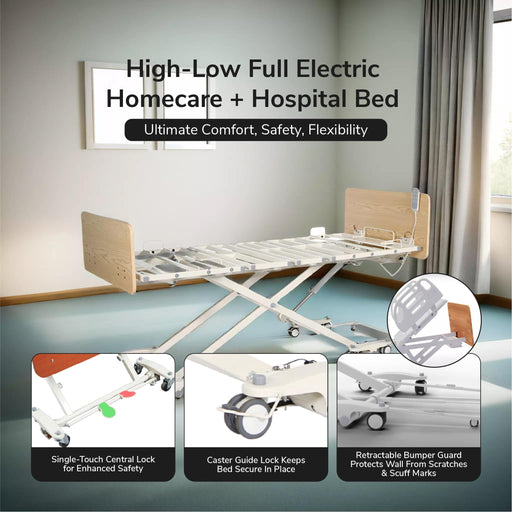
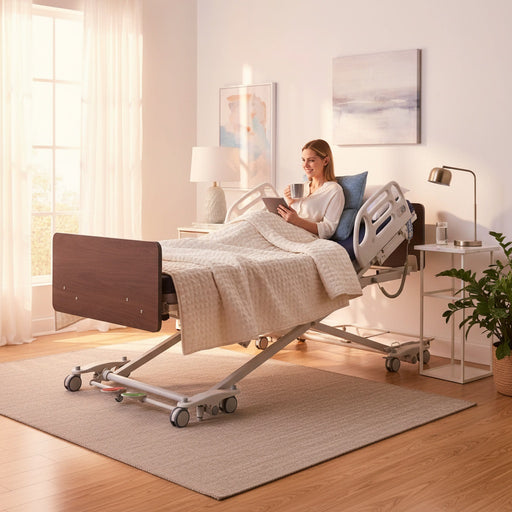
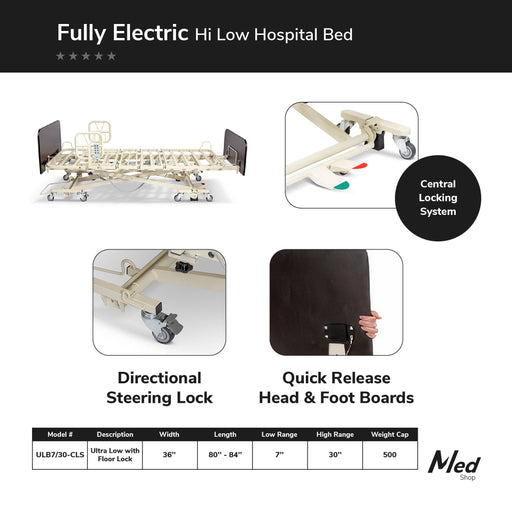
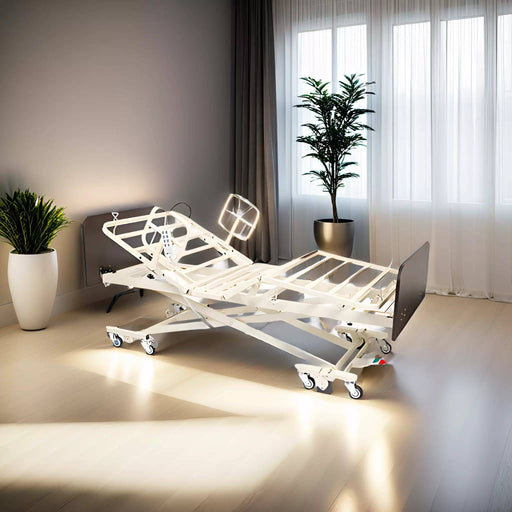


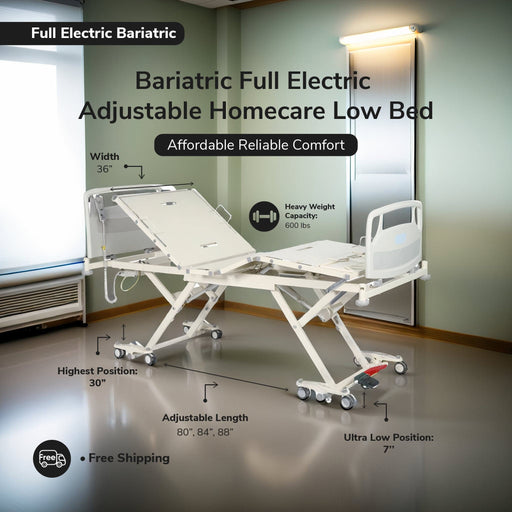
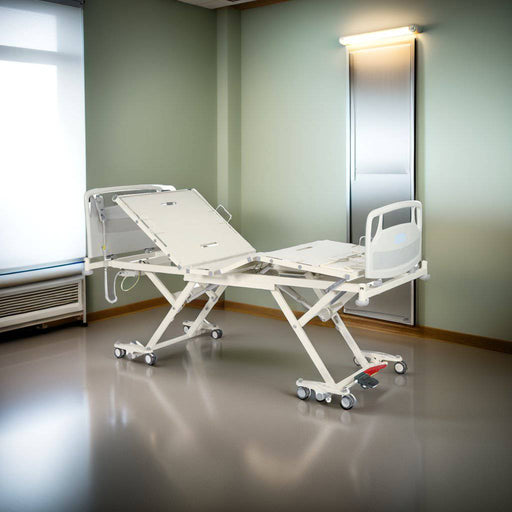
Leave a comment